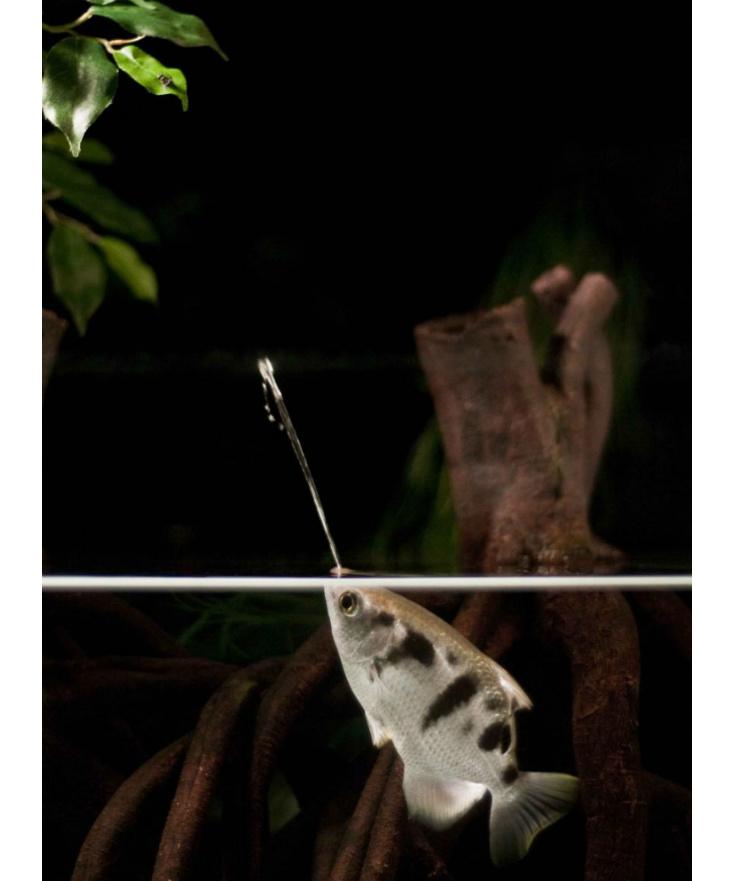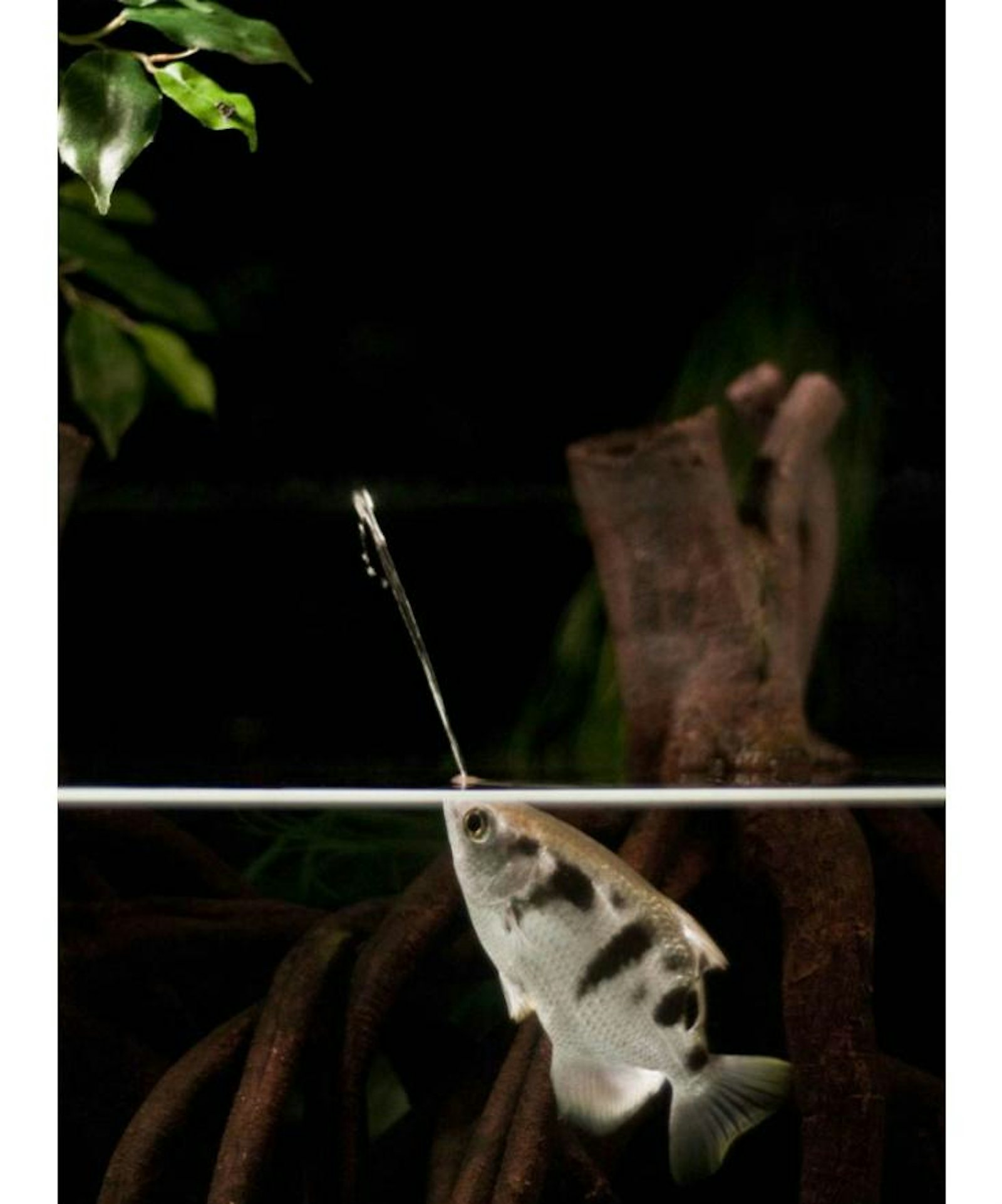
Few animals have had their cognitive abilities maligned like fish. Myths about their dullness abound—no doubt you’ve heard the one about goldfish’s three-second memories.
But have you also heard the one about gobies memorizing the location of rock pools? Or coral trout hunting in collaboration with moray eels? “They’re just not any less intelligent or sophisticated than terrestrial animals,” Australian biologist Culum Brown told Vox this summer.
Among the reasons we’ve been slow to come to grips with piscine intelligence is that fish behavior can be difficult to apprehend. We don’t often interact with them in their watery milieu, and they’re much tougher to read than, say, a chimpanzee. “They don’t have very expressive faces,” says Virginia Morell, author of Animal Wise. “They have other ways of communicating their mental states.”
Enter Toxotidae, the family that’s done more than any other to demonstrate fish cognition: the archerfish.
Archerfish—arrowhead-shaped creatures that prowl the brackish waters of Southeast Asia and Australia—have a unique method of capturing their prey: Like miniature surface-to-air–missile launchers, they fire jets of water that knock unsuspecting insects off foliage and into the water, where the archers devour them. To scientists who study animal minds, this sharpshooting isn’t just impressive, it’s an invaluable aid to research. That’s because the projectiles make it easy to tell where an archerfish’s attention is directed and whether it can perform tasks of visual discrimination, such as discerning different objects. “The same way you can train a dog—by giving it a piece of food and getting it to sit—you can train an archerfish to, say, shoot at a red circle instead of a blue circle,” says Cait Newport, a PhD candidate at the University of Queensland in Australia who studies fish neuroethology.
Little wonder, then, that archerfish are perhaps the most-studied fish in the field of animal cognition. Among their leading proponents is Stefan Schuster, a happy-go-lucky German neuroscientist at the University of Bayreuth who began working with the creatures by accident: When a supplier mistakenly sent him a huge home aquarium that wouldn’t fit in his apartment, he brought the tank to his lab, where he was studying decision-making in electric fish. At first, the archerfish were not subjects but pets, living in the oversized aquarium. Eventually Schuster realized they were the perfect organism for his purposes. “It’s almost impossible to miss that something is really special about these fish,” he says.
Over the years, Schuster has documented a wide array of extraordinary archerfish abilities, none more remarkable than social learning. In the wild, archerfish typically shoot perched insects; in the lab, however, Schuster trained some of them to gun down mobile targets by slowly moving objects above the surface of the tank. (To complete the challenge, fish invented two different strategies: They learned to shoot where the target was going to be, and they adopted a “turn and fire” maneuver whereby their bodies rotated as the targets shifted.) Then he had a group of four fish, which had previously been unable to make these difficult shots, watch a single expert archerfish shoot at objects in motion. When he tested the four observers again, he found that they’d learned to hit moving targets simply by studying their skilled tankmate, like a person who figures out how to shoot skeet by watching a friend blast clay pigeons.
As it turned out, the world wasn’t quite ready for Schuster’s research. After all, even chimps struggled with social learning, and scientists who reviewed Schuster’s work had a hard time believing that small-brained fish were capable of such feats. Every archerfish shot requires a bevy of complex calculations: Not only do the fish have to aim their water jets while compensating for refraction and distance, they also have to determine exactly where their prey will land, so that they can beat other fish to the spot. (See Aatish Bhatia’s excellent breakdown of the physics of the archerfish’s strike.) Some researchers dismissed that calculus as the base instinct of a primitive brain. “In humans, we’d see those rapid decisions as a sign of great intelligence—but [Schuster’s] critics say archerfish make them too quickly,” says Morell. “That just shows our bias. We want to be the only species capable of doing these things.”
These days, Schuster is conducting simplified social-learning experiments that he expects will be more palatable to skeptics. He’s also studying how archerfish form their water jets, and has found the creatures modulate the diameter of their mouths to adjust the shape and speed of their water rockets depending on the distance of the shot.
That discovery should impress even the staunchest critics of fish intelligence. “By the strictest definitions of tool use, the animal has to shape the tool in a task-specific manner,” says Schuster. A chimpanzee that plunges a stick into a termite mound, for instance, is less clearly a tool-user than a chimp that first chews the stick into a brush-tipped probe that’s better for catching insects. “By this standard, archerfish could not be called tool-users before. But now that we know that they adapt the jet for different targets, we can be on the safe side and say, yes, this really is an instance of tool use.” Archerfish, in other words, shape water the way a human might manipulate a spear.
So are archerfish the geniuses of the piscine world? Not exactly: Cait Newport says other species are able to perform equally demanding tasks. “The behaviors we’ve seen in archerfish are comparable to goldfish,” she told me. Last year, Newport Newport demonstrated that archerfish learn to discriminate between different stimuli—a notable ability, but one that all tested fish appear to possess. Newport is just as impressed by the behavior of other species, like cleaner wrasse that perform rituals to convince predators to let the wrasse pick off parasites.
Newport may also be bumping against some boundaries of archerfish intellect. In an experiment published this spring, her lab investigated whether archerfish are capable of “concept learning,” the ability to place various stimuli into different contextual categories. (Concept learning has thus far been demonstrated in primates and some birds.) To gauge this aptitude, Newport administered a pair of tests, including what’s called an “Odd-One-Out” test. Having learned to shoot, say, the shape of a star among three squares, could archerfish apply that same concept—spit at the unusual object—to hit an X among three triangles?
The fish, it turned out, didn’t make the leap. Newport speculates that visually singling out unusual objects isn’t ecologically relevant to archerfish—maybe they spit at everything and only decide whether to ingest their victim once they’ve tasted it. By contrast, Newport thinks that other fish, like a coral reef predator called the dottyback (Pseudochromis fuscus), might prove better at tests like “Odd-One-Out,” since predators often target prey that looks different from other fish in a school.
Just as humans can perform mental gymnastics that other mammals can’t—and vice versa—so, too, is it possible that various fish species have evolved different forms of intelligence based on their ecology and environment. And no one who works with archerfish doubts they’ve mastered their signature behavior. “If there’s even a tiny crack under the tank lid, they’ll just start spitting through it,” says Newport. “They love hitting my computer, my mobile phone, my face. They’ll hit anything they can spit at.”
Ben Goldfarb is a Seattle-based environmental journalist and correspondent at High Country News. He tweets @ben_a_goldfarb.






























